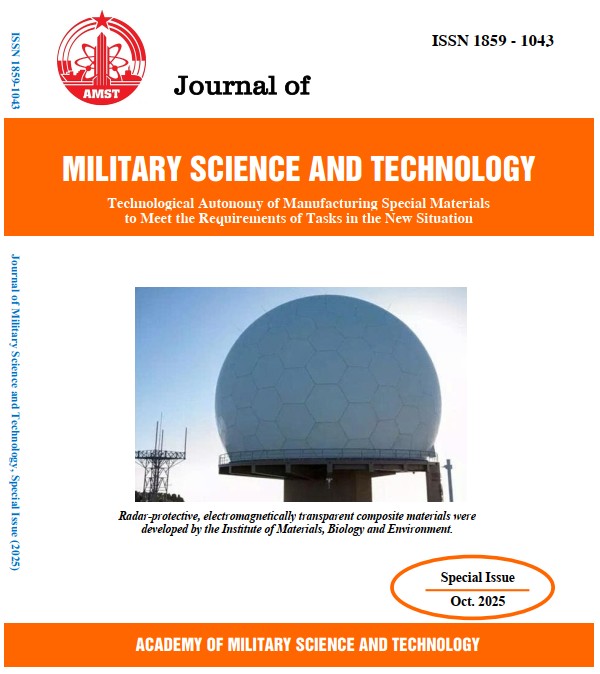Research on the application of UV/Peroxone technology for treating TNT-containing wastewater generated from bomb and explosives deployment processes
98 viewsDOI:
https://doi.org/10.54939/1859-1043.j.mst.IMBE.2025.136-143Keywords:
TNT; UV/Peroxone; Bombs and explosives; Level-5 munitions; Advanced oxidation processes (AOPs).Abstract
Wastewater from dismantling level-5 bombs, explosives, and munitions contains high levels of 2,4,6-trinitrotoluene (TNT), intense color, and exhibits high toxicity and environmental persistence, making it difficult to treat by conventional methods. This study investigates the application of the UV/Peroxone process for TNT and color removal. Key factors, including pH, H₂O₂ concentration, UV intensity, reaction time, and recirculation rate, were examined. Treatment efficiency increased with H₂O₂ concentration, UV intensity, and recirculation rate, while initial pH had a negligible impact. TNT and color removals of 96% and 93%, respectively, were achieved, meeting QCVN 40:2025/BTNMT (column C) and TCVN/QS 658:2011 (column B) standards, demonstrating the process’s potential for practical application.
References
[1]. Pham Son Tung et al., "Treatment of TNT contained water using UV-Fenton process", Journal of Military Science and Technology, 82, 98–104, (2022). https://doi.org/10.54939/1859-1043.j.mst.82.2022.98-104. DOI: https://doi.org/10.54939/1859-1043.j.mst.82.2022.98-104
[2]. Nguyen D. K. D., Nguyen D. Tan, and Hoang K. Hue, "Study on the characteristics of TNT decomposition reaction using Peroxone oxidant under conditions without and with UV irradiation", Journal of Chemical, Physical and Biological Analysis, 20, (2015).
[3]. Van Nguyen H. et al., "Effective treatment of 2,4,6-trinitrotoluene from aqueous media using a sono–photo-Fenton-like process with a zero-valent iron nanoparticle (nZVI) catalyst", RSC Advances, 14, 23720–23729, (2024). https://doi.org/10.1039/d4ra03907f. DOI: https://doi.org/10.1039/D4RA03907F
[4]. Nguyen Van Hoang et al., "2,4-Dinitrotoluene (DNT) Removal Efficiency Using the Sono-Photo-Fenton Process Combined with Nano Zero Valent Iron (nZVI) Heterogeneous Catalysis", VNU Journal of Science: Earth and Environmental Sciences, 40, 149–158, (2024). https://doi.org/10.25073/2588-1094/vnuees.5195. DOI: https://doi.org/10.25073/2588-1094/vnuees.5195
[5]. Krzywicka A. K.-K., "The comparison of efficiency of Fenton and photo-Fenton treatment of stabilized landfill leachate", Environmental Protection and Natural Resources, 26(3), 49–53, (2015). https://doi.org/10.1515/oszn-2015-0020. DOI: https://doi.org/10.1515/oszn-2015-0020
[6]. Nguyen Manh Khai et al., "Study on Removal of Styphnic Acid in Aquatic Environment by using UV-H₂O₂/nano TiO₂", VNU Journal of Science: Earth and Environmental Sciences, 34, 98–103, (2018). https://doi.org/10.25073/2588-1094/vnuees.43139.
[7]. Miranzadeh M. R. et al., "Evaluation of Efficacy of Advanced Oxidation Processes Fenton, Fenton-like and Photo-Fenton for Removal of Phenol from Aqueous Solutions", Journal of Chemical Society of Pakistan, 37, 266–271, (2015).
[8]. Clarizia L., Di Somma D., Marotta R., and Andreozzi R., "Homogeneous photo-Fenton processes at near neutral pH: a review", Applied Catalysis B: Environmental, 209, 358–379, (2017). https://doi.org/10.1016/j.apcatb.2017.03.011. DOI: https://doi.org/10.1016/j.apcatb.2017.03.011
[9]. Babuponnusami A. and Muthukumar K., "A review on Fenton and improvements to the Fenton process for wastewater treatment", Journal of Environmental Chemical Engineering, 2, 557–572, (2014). https://doi.org/10.1016/j.jece.2013.10.011. DOI: https://doi.org/10.1016/j.jece.2013.10.011
[10]. Nguyen Van Huong et al., "Application of Response Surface Methodology to Optimize Mononitrotoluene Aquatic Removal by Photo-Fenton Process", VNU Journal of Science: Earth and Environmental Sciences, 40, 66–73, (2024). https://doi.org/10.25073/2588-1094/vnuees.5192. DOI: https://doi.org/10.25073/2588-1094/vnuees.5192
[11]. Nguyen Dinh Hung et al., "Nghiên cứu ứng dụng công nghệ quang Fenton để xử lý nước thải phát sinh từ quá trình xì tháo bom mìn, vật nổ", Journal of Military Science and Technology, Special Issue of Scientific conference for graduate students and young researchers, 144–151, (2021) (in Vietnamese).







